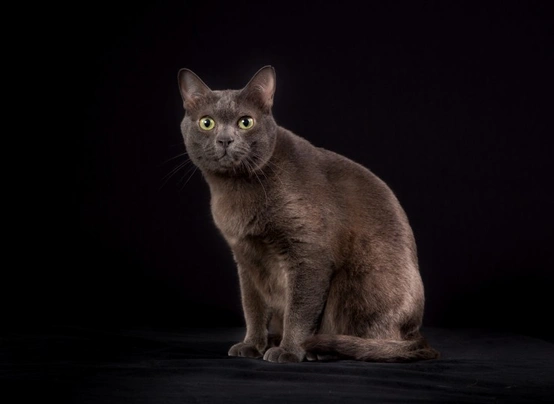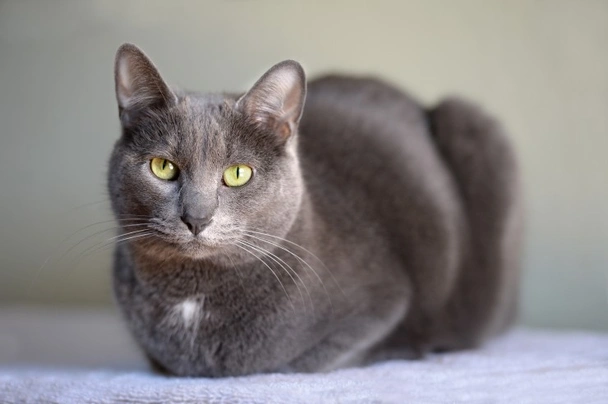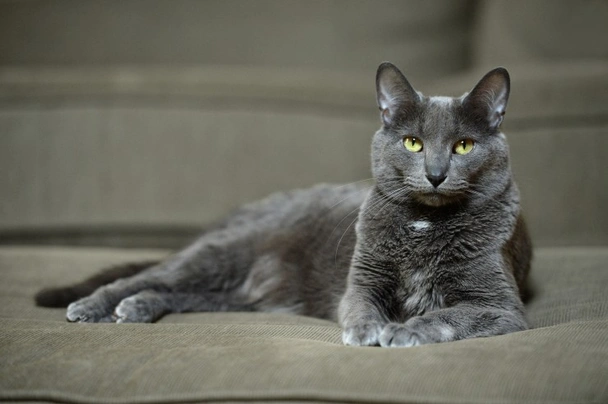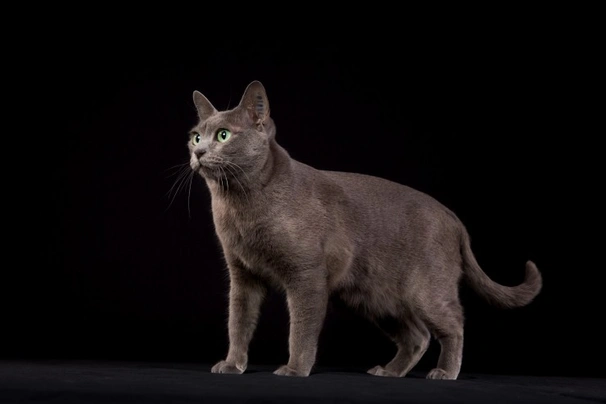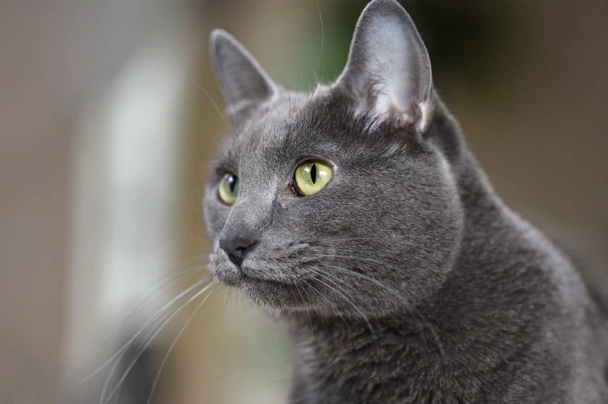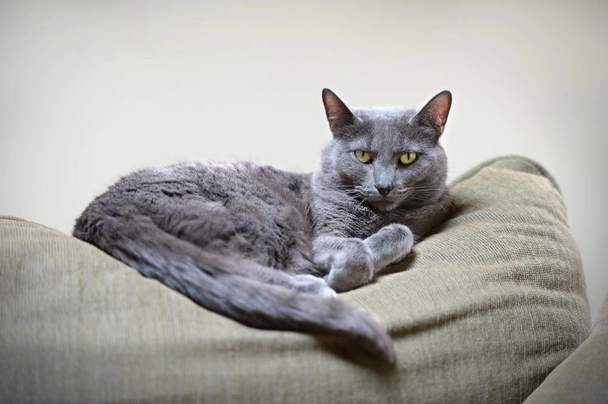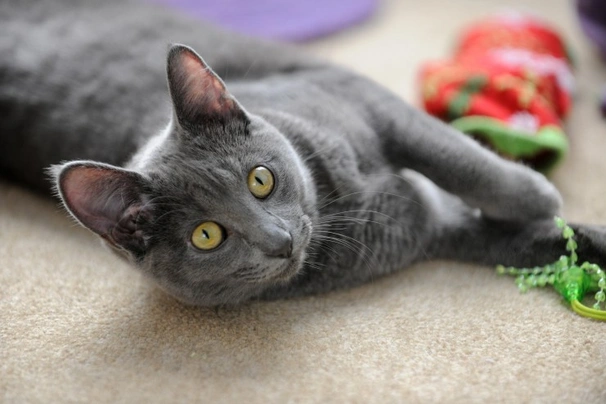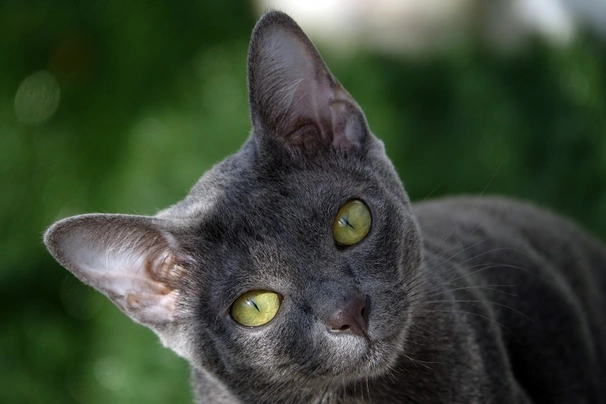Korat
Introduction of the Korat
The Korat is native to Thailand where they are called "Si-Sawat" which translated means "greyish-blue cat" and in their native land they have always been highly prized because they are thought to bring good luck. They are a rare breed and anyone wanting to share their homes with a Korat would need to register their interest with breeders an agree to go on a waiting list for the pleasure of owning such a striking loyal and affectionate cat.
History of the Korat
The Korat is an ancient breed with records of the breed in the Bangkok National Library called the Cat-Book Poems. The breed is thought to be over 600 years old and has always been revered in their native Thailand for bringing good luck. However Korats were allowed to interbreed with Siamese and Copper cats and it was quite common to find all three breeds in a single litter.
It was not until 1959 that the first Korats were introduced to America when a breeder had been offered two cats from another Thai breeder at the time. The two Korats were called Nara and Darra. These cats were also allowed to breed with Siamese although any kittens that did not boast blue coats were never registered as being Korats and they were not described as being Korats either. As such all Korats carry the genes that produce Siamese or lilac cats and this means generations down the line a Korat may well produce a Siamese kitten in a litter.
It was not until 1965 that a breed club was established with the end goal being to produce a breed standard. Korats were awarded Championship status in the States a year later in 1966. However it was not until around 10 years later in 1972 that Korats first appeared in the UK. Two years later there were over 20 cats in Britain but it was not until 1984 that the breed was awarded Championship status by the GCCF.
Today the Korat remains a rare breed even in their native Thailand and with a policy of no outcrossing having been put in place they are one of the more "natural" blue coated cats on the planet. Over the years these fascinating cats have found a fan base both here in the UK and elsewhere in the world thanks to their striking looks and the fact they are so people-oriented. However anyone wanting to share a home with a Korat would need to go on a waiting list for the pleasure of doing so because they are still so rare.
Appearance of the Korat
The Korat is an elegant medium size cat that boasts a lithe muscular body with females being daintier than their male counterparts. The breed is renowned for their large eyes which are a stunning green and their coats which boast having a silvery sheen on them. They are also known for being extremely talkative especially when greeting an owner and at meal times.
They have heart-shaped heads with a nice width in between the eyes and which curves gently to a well-developed muzzle. Their foreheads are flat and large and noses short having a slight downward curve to them. When seen in profile cats have a slight stop in between their noses and their foreheads. Chins are strong and their jaws are strong too. The Korat has large ears that boast having rounded tips and a large flare at their base. Ears are set high which adds to the Korat's keen alert expression. There is very little hair inside of a cat's ears and their eyes are large and bright being quite prominent and rounded with a slight slant when they are closed but not when they are open.
The Korat has a medium size strong and muscular body that's quite cobby in appearance with males being larger and more powerful than their female counterparts. They have a slight gentle curve in their backs and their legs are nicely in proportion with the rest of a cat's body. Paws are oval shaped with cats having five toes on their front feet and only four on their back ones. Their tails are medium in length being heavier at the base before tapering to a rounded tip.
When it comes to their coat the Korat boasts having a short close lying short to medium length coat that's fine to the touch and very glossy. The hair on the spine tends to break when a cat moves. The accepted breed colour under the GCCF breed standard is as follows:
Any shade of blue with each hair being tipped with silver nose and lip colour should be either dark blue or lavender and paw pads can range from being a dark blue to lavender.
Temperament of the Korat
The Korat is an extremely people-oriented cat and one that thrives on being with their owners. Some even insist on going in the car so they can spend time with the people they love. They make wonderful companions and family pets because they thrive in a home environment loving nothing more than to be included in everything that goes on around them.
They mature slowly which can take anything up to four years which means they retain many of their kitten traits up until then and even into their senior years. They are also quite talkative and love to have conversations with their families although they don't tend to be as vocal as their Siamese cousins. They are also highly intelligent learning things quickly which includes fetching toys. Being energetic cats by nature the Korat loves to play interactive games which is just one of the reasons they make such great companions and family pets.
Because they thrive on human contact the Korat does not like to be left on their own for any length of time. With this in mind they are best suited to families where at least one person stays at home when everyone else is out of the house. They love exploring the great outdoors and being able to mark their territory but they should only be allowed out if it is safe for them to do so. The good news is that Korats adapt very well to being kept as indoor pets as long as they are given lots of things to do and places for them to snuggle up when the mood takes them.
Intelligence / Trainability of the Korat
The Korat is known to be a highly intelligent cat and one that learns new things extremely quickly and this includes retrieving toys and playing ball with their owners. Because they are so smart Korats like to be kept busy and love to be involved in everything that goes on around them. If they get bored cats often find their own ways of amusing themselves which could result in them being destructive around the home. This is their way of relieving their boredom and any stress they may be experiencing and why it’s so important to invest in lots of interactive toys.
Children and other
Korats with their outgoing affectionate personalities are the perfect choice for families with children. They are quick and agile on their feet and therefore know when to get out of the reach of smaller children when they get too boisterous or loud. However care always has to be taken when cats are around toddlers and any interaction should always be supervised by an adult to make sure things stay nice and calm. Younger children need to be taught how to behave around cats and when to leave them alone.
They also get on well with dogs especially if they have grown up together in the same household. However care has to be taken when introducing a Korat to dogs they don't already know just in case the dog does not get on with their feline counterparts. If they have grown up with another cat in a household they generally get on well together although there may be the occasional spat when cats re-establish the pecking order which they do from time to time. Korats are incredibly social by nature and have been known to get on with other pets. However it's always wiser to keep a close eye on any cat when they are around smaller pets just to be on the safe side.
Health of the Korat
The average life expectancy of a Korat is between 15 and 18 years when properly cared for and fed an appropriate good quality diet to suit their ages.
The Korat is known to suffer from few hereditary health issues but they are prone to two types of genetic disorder which often sees cats dying before they are 12 months old and which are as follows:
- GM1 - Breeders should have stud cats tested before using them in a breeding programme
- GM2 - Breeders should have stud cats tested before using them in a breeding programme
Caring for the Korat
As with any other breed Korats need to be groomed on a regular basis to make sure their coats and skin are kept in top condition. On top of this cats need to be fed good quality food that meets all their nutritional needs throughout their lives which is especially true of kittens and older cats.
Grooming of the Korat
Korats boast having short close lying single coats and as such they are low maintenance on the grooming front. A weekly brush and wipe over with a chamois leather is all it takes to keep their coats in good condition with a nice sheen on it. Like other cats they tend to shed the most in the Spring and then again in the Autumn although a lot less than many other breeds thanks to their single coats.
It's also important to check a cat's ears on a regular basis and to clean them when necessary. If too much wax is allowed to build up it can lead to a painful infection which can be hard to clear up. In short prevention is often easier than cure with ear infections. Cats often suffer from ear mites which can be a real problem which is why it's so important to check their ears on a regular basis.
Exercise of the Korat
The Korat boasts having a ton of energy and love to be doing things in between their cat naps that is. They also love to play interactive games which includes retrieving toys and balls when they are thrown for them. They thrive on being around their owners and will follow them wherever they go with some cats even insisting on going in the car so they can be with them.
Cats when kept as indoor pets need to be given lots of things to do and places they can snuggle up for a snooze when the mood takes them because if there is one Korats enjoy it's napping during the day. They also love lying in the warmest spot on a windowsill which means making sure it's wide enough for them to do so comfortably.
Feeding of the Korat
If you get a Korat kitten from a breeder they would give you a feeding schedule and it's important to stick to the same routine feeding the same kitten food to avoid any tummy upsets. You can change a kitten's diet but this needs to be done very gradually always making sure they don't develop any digestive upsets and if they do it's best to put them back on their original diet and to discuss things with the vet before attempting to change it again.
Older cats are not known to be fussy eaters but this does not mean they can be given a lower quality diet. It's best to feed a mature cat several times a day making sure it's good quality food that meets all their nutritional requirements which is especially important as cats get older. It's also essential to keep an eye on a cat's weight because if they start to put on too much it can have a serious impact on their overall health and wellbeing. Like all other breeds Korats need free access to fresh clean water at all times.
Korat price
If you are looking to buy a Korat you would need to pay upwards of £250 for a well-bred pedigree kitten and you would need to register your interest with breeders and agree to being put on a waiting list because not many well-bred kittens are registered with the GCCF every year. The cost of insuring a male 3-year-old Korat in northern England would be £16.27 a month for basic cover but for a lifetime policy this would set you back £23.79 a month (quote as of September 2017). When insurance companies calculate a pet's premium they factor in several things which includes where you live in the UK a cat's age and whether or not they have been neutered or spayed among other things.
When it comes to food costs you need to buy the best quality food whether wet or dry making sure it suits the different stages of a cat’s life. This would set you back between £15 - £20 a month. On top of all of this you need to factor in veterinary costs if you want to share your home with a Korat and this includes their initial vaccinations their annual boosters the cost of neutering or spaying a cat when the time is right and their yearly health checks all of which quickly adds up to over £500 a year.
As a rough guide the average cost to keep and care for a Korat would be between £30 to £50 a month depending on the level of insurance cover you opt to buy for your cat but this does not include the initial cost of buying a well-bred kitten.

4 Adorable Kittens
£50
Korat Kittens
£750
